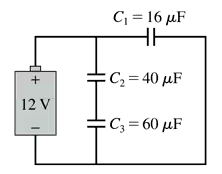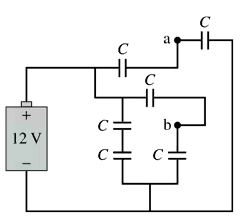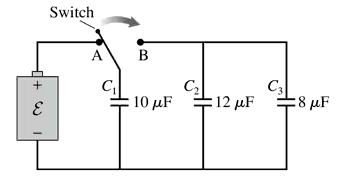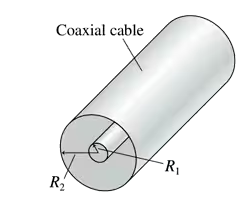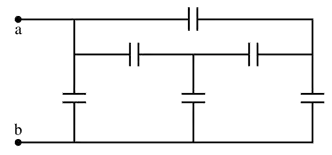 Back
BackProblem 49a
Two positive point charges q are located on the y-axis at y = ±a. Write an expression for the electric potential at position x on the x-axis.
Problem 49c
Two positive point charges q are located on the y-axis at y = ±a. Symmetry dictates that the electric field along the x-axis has only an x-component: Ey=Ez=0. Find an expression for Ex if x≪a.
Problem 49e
Two positive point charges q are located on the y-axis at y = ±a. Your answer to part d shows that an electron experiences a linear restoring force, so it will undergo simple harmonic motion. What is the oscillation frequency in GHz for an electron moving between two 1.0 nC charges separated by 2.0 mm?
Problem 51
Metal sphere 1 has a positive charge of 6.0 nC. Metal sphere 2, which is twice the diameter of sphere 1, is initially uncharged. The spheres are then connected together by a long, thin metal wire. What are the final charges on each sphere?
Problem 52b
Two 2.0 cm×2.0 cm metal electrodes are spaced 1.0 mm apart and connected by wires to the terminals of a 9.0 V battery. The wires are disconnected, and insulated handles are used to pull the plates apart to a new spacing of 2.0 mm. What are the charge on each electrode and the potential difference between them?
Problem 53
The electric potential is 40 V at point A near a uniformly charged sphere. At point B, 2.0 μm farther away from the sphere, the potential has decreased by 0.16 mV. How far is point A from the center of the sphere?
Problem 54
Find expressions for the equivalent capacitance of (a) N identical capacitors C in parallel and (b) N identical capacitors C in series.
Problem 55a
Two 2.0 cm×2.0 cm metal electrodes are spaced 1.0 mm apart and connected by wires to the terminals of a 9.0 V battery. What are the charge on each electrode and the potential difference between them?
Problem 57
What are the charge on and the potential difference across each capacitor in FIGURE P26.57?
Problem 59b
Six identical capacitors with capacitance C are connected as shown in FIGURE P26.59. What is the potential difference between points a and b?
Problem 61
Initially, the switch in FIGURE P26.61 is in position A and capacitors C₂ and C₃ are uncharged. Then the switch is flipped to position B. Afterward, the voltage across C₁ is 4.0 V. What is the emf of the battery?
Problem 63
Capacitors C₁ = 10 μF and C₂ = 20 μF are each charged to 10 V, then disconnected from the battery without changing the charge on the capacitor plates. The two capacitors are then connected in parallel, with the positive plate of C₁ connected to the negative plate of C₂ and vice versa. Afterward, what are the charge on and the potential difference across each capacitor?
Problem 64
An isolated 5.0 μF parallel-plate capacitor has 4.0 mC of charge. An external force changes the distance between the electrodes until the capacitance is 2.0 μF. How much work is done by the external force?
Problem 65
You've built a device that uses the energy from a rapidly discharged capacitor to launch the capacitor straight up. One capacitor, with a mass of 3.5 g, is launched to a height of 1.6 m after having been charged to 100 V. What is its capacitance in μF?
Problem 67
The label rubbed off one of the capacitors you are using to build a circuit. To find out its capacitance, you place it in series with a 10 μF capacitor and connect them to a 9.0 V battery. Using your voltmeter, you measure 6.0 V across the unknown capacitor. What is the unknown capacitor's capacitance?
Problem 68b
High-frequency signals are often transmitted along a coaxial cable, such as the one shown in FIGURE P26.68. For example, the cable TV hookup coming into your home is a coaxial cable. The signal is carried on a wire of radius R1 while the outer conductor of radius R2 is grounded (i.e., at V=0 V). An insulating material fills the space between them, and an insulating plastic coating goes around the outside. Evaluate the capacitance per meter of a cable having R1=0.50 mm and R2=3.0 mm.
Problem 70
The current that charges a capacitor transfers energy that is stored in the capacitor's electric field. Consider a 2.0 μF capacitor, initially uncharged, that is storing energy at a constant 200 W rate. What is the capacitor voltage 2.0 μs after charging begins?
Problem 71
A vacuum-insulated parallel-plate capacitor with plate separation d has capacitance C0. What is the capacitance if an insulator with dielectric constant κ and thickness d/2 is slipped between the electrodes without changing the plate separation?
Problem 74
Derive Equation 26.33 for the induced surface charge density on the dielectric in a capacitor.
Problem 78a
An electric dipole at the origin consists of two charges ±q spaced distance s apart along the y-axis. Find an expression for the potential V(x, y) at an arbitrary point in the xy-plane. Your answer will be in terms of q, s, x, and y.
Problem 78c
An electric dipole at the origin consists of two charges ±q spaced distance s apart along the y-axis. Assuming s≪x and y, find expressions for Ex and Ey, the components of Ē for a dipole.
Problem 78e
An electric dipole at the origin consists of two charges ±q spaced distance s apart along the y-axis. What is the field Ē on the bisecting axis? Does your result agree with Equation 23.11?
Problem 79
Charge is uniformly distributed with charge density ρ inside a very long cylinder of radius R. Find the potential difference between the surface and the axis of the cylinder.
Problem 80b
Consider a uniformly charged sphere of radius R and total charge Q. The electric field Eout outside the sphere (r≥R) is simply that of a point charge Q. In Chapter 24, we used Gauss’s law to find that the electric field Ein inside the sphere (r≤R) is radially outward with field strength . What is the ratio Vcenter/Vsurface?
Problem 81a
Find an expression for the capacitance of a spherical capacitor, consisting of concentric spherical shells of radii R1 (inner shell) and R2 (outer shell).
Problem 81b
A spherical capacitor with a 1.0 mm gap between the shells has a capacitance of 100 pF. What are the diameters of the two spheres?
Problem 83
Each capacitor in FIGURE CP26.83 has capacitance C. What is the equivalent capacitance between points a and b?

